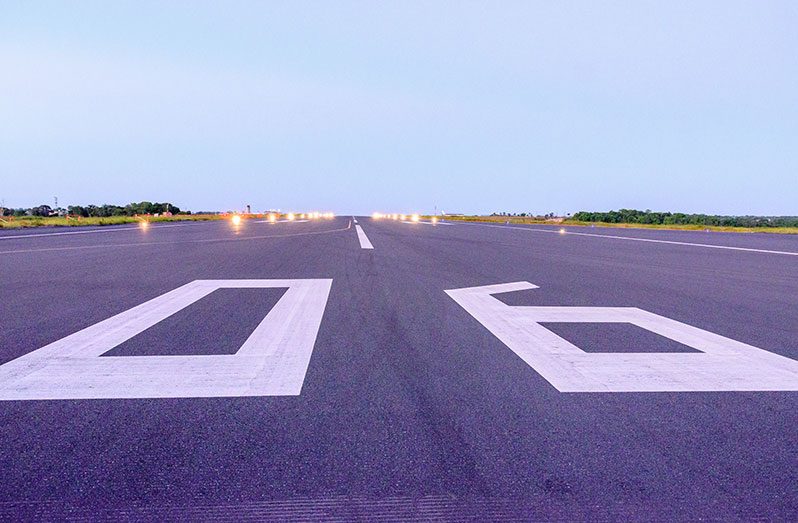A NEW Instrument Landing System (ILS) worth $518 million and an expansion of the runway at the Cheddi Jagan International Airport (CJIA) to 3,360 metres, geared towards accommodating larger aircrafts and maintaining international safety standards, were commissioned at the airport on Sunday.
Among those who witnessed the commissioning were Public Works Minister, Bishop Juan Edghill; Tourism, Industry and Commerce Minister, Oneidge Walrond; Home Affairs Minister, Robeson Benn and CJIA Board Chair, Sanjeev Datadin.
Edghill explained that the government recognised that the aviation industry is capital intensive and hefty investments are required to ensure safety, critical aviation activities and infrastructure are compliant with international civil aviation standards.
The runway at the airport, which previously measured 2,270 metres, now boasts of being one of the longest such structures in the Caribbean region, measuring 3,360 metres with the new extension.

The north-eastern end of the asphaltic surface has benefitted from 400 metres of additional runway, and 250 metres of the Runway End Safety Area (RESA). Meanwhile, the south-eastern end of the runway was extended by some 690 metres, with an added 90 metres of RESA.
Minister Edghill explained that to enhance the safety and efficiency of aircraft operations on the now 11,023 feet runway, a suitable approach and landing aid was needed and this was materialised through the ILS.
The ILS is a precision-approach aid for pilots; it employs two radio signals that provide flyers with vertical and horizontal guidance during the landing phase of an aircraft. The localiser (LOC) provides ‘azimuth guidance’, while the glideslope (GS) defines the correct vertical descent profile.
To put it simply, the system will enable pilots to execute safer landings and take-offs, even during unfavourable weather conditions; the ILS guides airplanes down to the runway as low as 200 feet above the runway, at which point the pilot will be better able to make a visual descent to continue his landing.
The ILS installation now allows the airport to be in compliance with the International Civil Aviation Organisation’s (ICAO) Global Air Navigation Plan for Runways and Vertical Guidance
“Embracing aviation as one of the enabling sectors to support our national economic, social and cultural structures simply means we have to build and maintain an aviation system that is regionally and globally comparable,” Edghill said while delivering the keynote address at the ceremony.
WIDE RANGE OF BENEFITS
He explained that the new installation and expanded runway will provide a wide range of benefits for the airport, passengers, the airlines, and the country as a whole.
“A longer runway within context, provides more prepared surface for aircraft in the eventuality of aborted take-off. It also makes the airport more attractive to modern fleets and other airlines, thus making it more marketable,” Edghill said.

“The CJIA now has increased capacity for larger and modern carriers. Previously many wide-bodied aircraft including the B747 had to operate with restrictions into CJIA,” he added
The dominant aircraft types operating into CJIA are Boeing 737-800, Boeing 757 and 767-200. The expanded runway now accommodates most modern passenger carrying aircraft including Boeing 777, 787 and Airbus 350, 321.
The length of the runway available and the choice of a precision approach instrument landing system, Minister Edghill noted provide ease to the flight crews, and, by extension, the airlines, in poor weather conditions.
“Airlines’ delays and/or diversions due to bad weather will be reduced, thus any associated operational costs will be non-existent. Flight crews’ rest time will not be encroached due to diversions to cause further delays,” he said.
The longer runway available will allow aircraft to take-off with their optimal weight so airlines will now be able to carry their outgoing passengers’ baggage and the full fuel capacity for their flights, so no bags will be left behind.
“For the travelling public, those who have experienced diversion to an alternate destination airport due to heavy fog after a five- or six- hour flight will understand the frustration of delays, despite being in the interest of safety. Missing important timelines due to these delays can be costly,” Edghill said.
SOME RELIEF
“The newly certified ILS will bring some relief to these diversions. The ILS provides precision guidance to pilots allowing them to descend to a lower decision height which increases the probability of a safe landing in poor visibility conditions,” he added.
While the ILs will not completely eliminate diversions, it is estimated that diversions will be reduced by 90 per cent in severe weather conditions, which deter aircraft from landing.
In addition, as a result of the ILS, air traffic controllers and pilots will also benefit from situation awareness, enhanced prediction and resolution systems in the air and on the ground and approach monitoring which will enhance airspace safety.
“The aviation industry is of strategic significance to Guyana’s sustainable development … our government will continue to promote the development of this sector, but we must overcome the challenges that will present themselves as we strive towards building and sustaining a strong vibrant aviation sector,” Edghill said.
Minister Walrond explained that the airport has a significant impact on the tourism industry and at the rate at which Guyana’s tourism industry is poised to expand, the ILS and runway expansion are timely.



.jpg)








